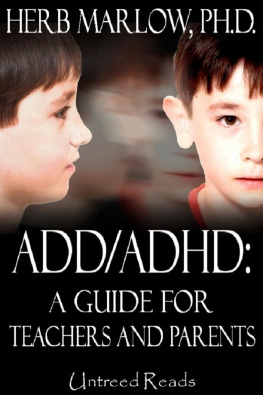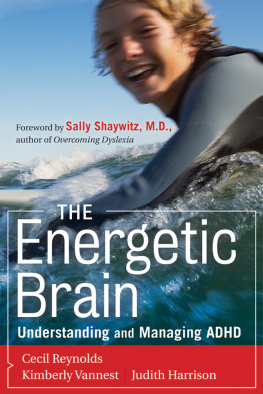Christopher Green is a paediatrician and honorary consultant to the Childrens Hospital, Westmead, in Sydney. Over the last 15 year, Dr Green has been prominent in introducing modern attitudes towards treatment of ADHD to Australia. More recently he has been influential in bringing this same message to parents and professionals in the United Kingdom.
He is the well-known author of three bestselling books on childcare, Toddler Taming (1984, 1990 and 2001), Babies! (1988, 1996 and 2001) and Beyond Toddlerdom (2000). Dr Green has run parenting seminars which reach over 20 000 Australian, New Zealand and United Kingdom parents every year. He is a former columnist with the Australian Womens Weekly .
Chris is married to Hilary, a part-time general practitioner and full-time mum. They have two sons. When not working he enjoys sailing, cycling and outdoors Australia with his family.
Kit Chee is a paediatrician specialising in the behavioural and learning problems of children. She is honorary physician at the Child Development Unit at the Childrens Hospital, Westmead, and consultant at the Sydney Learning Clinic.
Kit has a research interest in childrens learning, language, ADHD and the effect of stimulant medication. Kit is married to Arthur, also a paediatrician. Outside work every minute is taken up looking after her two young children, but she still finds time to enjoy music, the arts and exploring Sydney.

A. Either (1) or (2)
- Six (or more) of the following symptoms of inattention have persisted for at least 6 months to a degree that is maladaptive and inconsistent with developmental level:
Inattention
(a) often fails to give close attention to details or makes careless mistakes in schoolwork, work or other activities
(b) often has difficulty sustaining attention in tasks or play activities
(c) often does not seem to listen when spoken to directly
(d) often does not follow through on instructions and fails to finish schoolwork, chores or duties in the workplace (not due to oppositional behaviour or failure to understand instructions)
(e) often has difficulty organising tasks and activities
(f) often avoids, dislikes or is reluctant to engage in tasks that require sustained mental effort (such as schoolwork or homework)
(g) often loses things necessary for tasks or activities (eg toys, school assignments, pencils, books or tools)
(h) is often easily distracted by extraneous stimuli
(i) is often forgetful in daily activities
2. Six (or more) of the following symptoms of hyperactivityimpulsivity have persisted for at least 6 months to a degree that is maladaptive and inconsistent with developmental level:
Hyperactivity
(a) often fidgets with hands or feet or squirms in seat
(b) often leaves seat in classroom or in other situations in which remaining seated is expected
(c) often runs about or climbs excessively in situations in which it is inappropriate (in adolescents or adults, may be limited to subjective feelings of restlessness)
(d) often has difficulty playing or engaging in leisure activities quietly
(e) is often on the go or often acts as if driven by a motor
(f) often talks excessively
Impulsivity
(g) often blurts out answers before questions have been completed
(h) often has difficulty awaiting turn
(i) often interrupts or intrudes on others (eg butts into conversations or games)
B. Some hyperactiveimpulsive or inattentive symptoms that caused impairment were present before age 7 years.
C. Some impairment from the symptoms is present in two or more settings (eg at school [or work] and at home).
D. There must be clear evidence of clinically significant impairment in social, academic or occupational functioning.
E. The symptoms do not occur exclusively during the course of a Pervasive Developmental Disorder, Schizophrenia or other Psychotic Disorder and are not better accounted for by another mental disorder (eg Mood Disorder, Anxiety Disorder, Dissociative Disorder or a Personality Disorder).
Code based on type:
314.01 Attention Deficit Hyperactivity Disorder, Combined Type: if both Criteria A1 and A2 are met for the past 6 months
314.00 Attention Deficit Hyperactivity Disorder, Predominantly Inattentive Type: if Criterion A1 is met but Criterion A2 is not met for the past 6 months
314.01 Attention Deficit Hyperactivity Disorder, Predominantly HyperactiveImpulsive Type: if Criterion A2 is met but Criterion A1 is not met for the past 6 months
Coding note: For individuals (especially adolescents and adults) who currently have symptoms that no longer meet full criteria, In Partial Remission should be specified.
314.9 Attention Deficit Hyperactivity Disorder not otherwise specified
This category is for disorders with prominent symptoms of inattention or hyperactivityimpulsivity that do not meet criteria for Attention Deficit Hyperactivity Disorder.
Reprinted with permission from the Diagnostic and Statistical Manual of Mental Disorders , Fourth Edition. American Psychiatric Association, Washington, DC, 1994.

A. A pattern of negativistic, hostile and defiant behaviour lasting at least 6 months, during which four (or more) of the following are present:
(1) often loses temper
(2) often argues with adults
(3) often actively defies or refuses to comply with adults requests or rules
(4) often deliberately annoys people
(5) often blames others for his or her mistakes or misbehaviour
(6) is often touchy or easily annoyed by others
(7) is often angry and resentful
(8) is often spiteful or vindictive
Note: Consider a criterion met only if the behaviour occurs more frequently than is typically observed in individuals of comparable age and developmental level.
B. The disturbance in behaviour causes clinically significant impairment in social, academic or occupational functioning.
C. The behaviours do not occur exclusively during the course of a Psychotic or Mood Disorder.
D. Criteria are not met for Conduct Disorder, and, if the individual is age 18 years or older, criteria are not met for Antisocial Personality Disorder.
Reprinted with permission from the Diagnostic and Statistical Manual of Mental Disorders , Fourth Edition. American Psychiatric Association, Washington, DC, 1994.

A. A repetitive and persistent pattern of behaviour in which the basic rights of others or major age-appropriate societal norms or rules are violated, as manifested by the presence of three (or more) of the following criteria in the past 12 months, with at least one criterion present in the past 6 months:
Aggression to people and animals
(1) often bullies, threatens or intimidates others
(2) often initiates physical fights
(3) has used a weapon that can cause serious physical harm to others (eg a bat, brick, broken bottle, knife, gun)
(4) has been physically cruel to people
(5) has been physically cruel to animals













